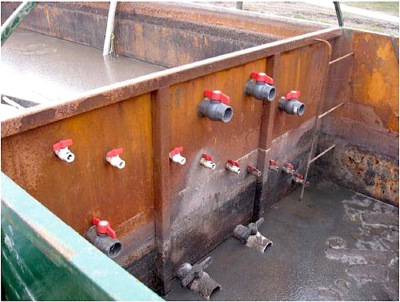Thursday, March 1st, 2012
Farmers to test settling tanks
Device could make it easier to export hog manure from Grand Lake Watershed
By Nancy Allen

Submitted Photo
Various sampling ports are visible in this manure settling tank prototype. The tank was built to try to concentrate phosphorous in the bottom layer of the manure. The ports with open and shut valves allow researchers to sample and test manure for phosphorous concentrations at different depths. The concept will be tested this spring at five local hog farms. The tanks could make it easier to transport hog manure out of the Grand Lake Watershed.
A local ag official is working with five swine farmers to test a manure settling tank concept that may make it easier to ship waste out of the Grand Lake Watershed.
Terry Mescher, a state agricultural engineer, said he has four to five swine farmers who have volunteered to use 55-gallon drums on their farms to test a Canadian design that allows nutrients in manure to sink to the bottom, with the liquid staying on top. A $4,000 state grant will be used to pay help for the testing.
"One of the things we've been struggling with is trying to make liquid manure more portable," Mescher said. "A lot of the dry (poultry) manure is getting brokered and is being trucked out of the watershed; liquid (hog) manure is very hard to transport because it's 95 percent water."
The idea of the settling tank is to produce a more nutrient rich, lower moisture sludge that is more economical to haul away. A main nutrient in manure, phosphorous, is useful as fertilizer but can damage water quality and cause harmful algae blooms if it runs off the land and into waterways.
"I'm hoping we can get the phosphorous dense enough in the sludge that economics will take care of the rest. Enough that it makes it worth it to put it in a truck and ship it 20-30 miles," Mescher said.
Leftover liquid could be used to irrigate crops as long its nutrient content is low. Mescher hopes to find more options for the liquid during the testing phase.
Farmers in the Grand Lake area are trying to find ways to reduce nutrient runoff from farmland, which is the major contributor of phosphorous in Grand Lake. The lake has suffered phosphorous-fed toxic algae blooms and water quality advisories the last three summers.
Jerry Will of Marion Township, one of the farmers agreeing to test the concept, hopes positive test results will en-courage others to try it.
"Something like this takes time and effort and a lot of people don't have the time, but if it's proved out, others will jump right in," Will said.
The test drums will be installed at the farms in early to mid-spring with preliminary results in June. If the tests are successful, the next step would be to design a unit for a farm, Mescher said. Federal funds may be available to help farmers pay for a covered, concrete unit.
"If we can prove out the concept and if we can get a preliminary design that allows us to draw the water off the top and get out the sludge from the bottom, then in the future, EQIP funds could be used to install them," he said.
Mescher said Canadian researchers, who have tested the concept for three years, have been able to capture 87 percent of the phosphorous in the bottom manure sludge. He's hoping to capture 70 to 80 percent in the local tests.
Most local swine manure is stored in concrete pits underneath hog buildings and the rest in earthen holding ponds or anaerobic lagoons.
With an earthen holding pond or concrete pit, pumps and agitators mix the manure to an even consistency before it is all land-applied.
Anaerobic lagoons store manure and break down the organic solids in a natural process, allowing much of the phosphorous to settle to the bottom. These lagoons are considerably larger because the manure has to be diluted with water in order to start the anaerobic process. Only a portion of the total volume is removed annually and land-applied.
Settling tanks could help farmers with land that cannot accept any more phosphorous, a pressing issue since new manure rules came into affect in the watershed. The rules resulted after the state designated the watershed distressed about a year ago due to humans and animals getting sick from algae toxins in the lake.
One of the new rules says that by Dec. 15 all of the roughly 300 livestock farmers in the watershed must have nutrient management plans. The plans require soil testing every three years to determine phosphorous levels that show where farmers can and cannot apply manure.
Mescher said he will report on the progress of the settling tank studies at monthly Ag Solutions meetings. The group includes watershed farmers trying to find economical solutions that reduce nutrient runoff and improve the condition of the lake.
Amiran Technologies, Oak Creek, Wis., a company looking to build a plant in the watershed that turns manure into organic fertilizer, may be interested in the phosphorous-rich manure sludge produced in settling tanks.
"We obviously would need to get samples of it and test it in our labs, but if the phosphorous concentrations were high enough, it would be able to be used in the production of the organic fertilizer," said Paul Chadwick, executive vice president of market development with Amiran Technologies. "I think technology like this would be a really nice fit for us."
Will said he's also hopeful the sludge can be used by Amiran Technologies.
"This way they wouldn't have to take all that water and maybe they could pay for it (manure) even," Will said. "But first we got to prove that it works."
More than 80,000 hogs are in the Grand Lake Watershed, according to a 2007 inventory of livestock in the watershed, the most recent data available.
Check online:
Go to
www.manure.mb.ca/livestock-industry.php scroll down to Research Projects (Non-MLMMI) and under the Solid/Liquid Separation of Hog Manure Utilizing a Settling Tank bullet click on Full Report or Farmscape Article 3119.


